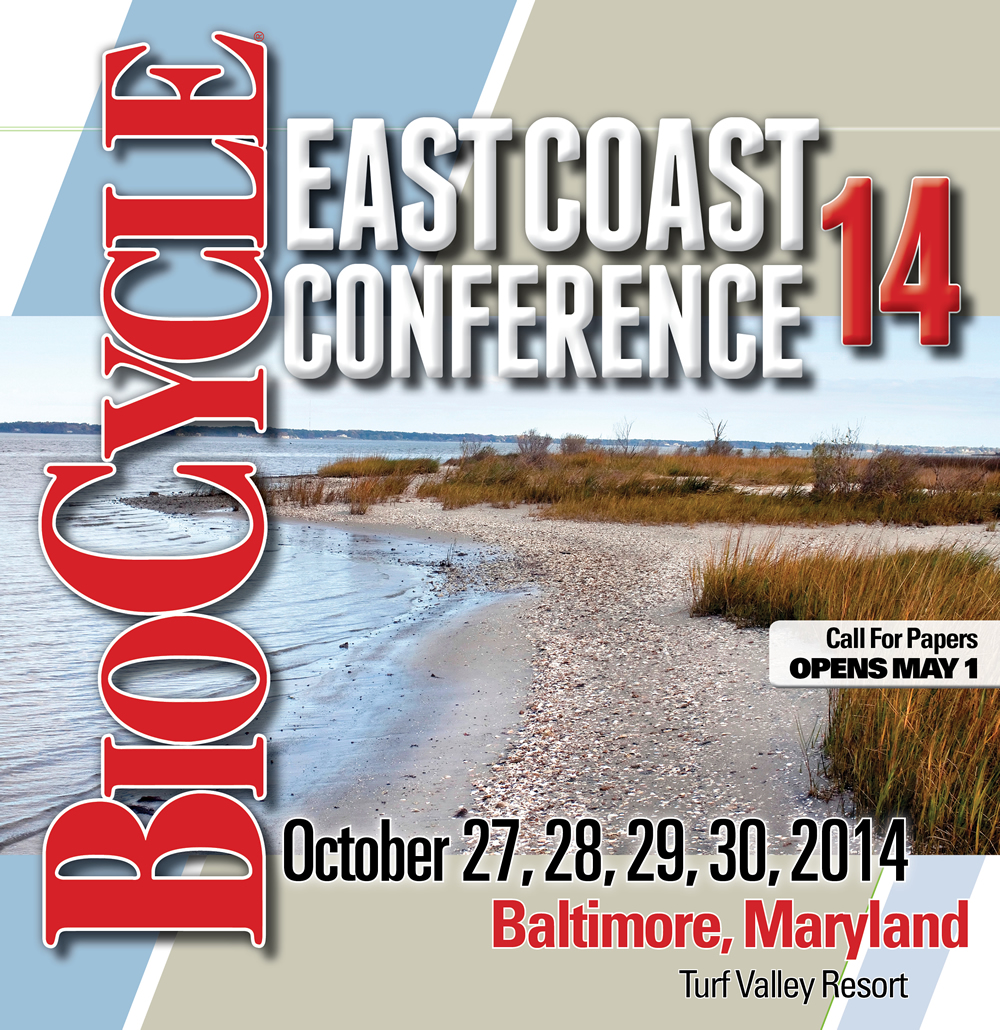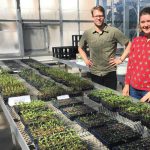BioCycle March/April 2014
U.S. Materials Recovery Rate at 34.5 Percent
In February 2014, the U.S. EPA released its annual report, “Municipal Solid Waste Generation, Recycling, and Disposal in the United States: Facts and Figures for 2012.” The report states that in 2012, Americans generated approximately 251 million tons of trash, of which 65 million tons were recycled and 21 million tons were composted, equating to a 34.5 percent recovery rate. This means that of the estimated 4.38 pounds of waste generated by an American in a given day, 1.51 pounds were either recycled or composted. Paper, paperboard, yard trimmings and food waste account for 55 percent of MSW. Although those materials alone account for 75 percent of the recovered MSW, food waste still accounts for 21 percent of discarded waste. This figure exhibits the need for continued organics recycling infrastructure, as well as reducing wasted food at its source. That being said, the total amount of MSW disposed in landfills has dropped almost 11 million tons since 1990, pointing to the success of recycling and composting diversion programs. Diverting MSW from the landfill has direct environmental benefits. According to EPA’s WARM methodology (www.epa.gov/warm), which calculates and totals greenhouse gas emissions of baseline and alternative waste management practices, by recycling and composting 87 million tons of MSW in 2012, the U.S. prevented the equivalent of 168 million metric tons of carbon dioxide emissions, comparable to removing emissions from over 33 million passenger vehicles from the road in one year. To download a PDF of the report, visit the “Municipal Solid Waste” section of the United States’ EPA website.
Support for Climate Change Policies
In February 2014, researchers from the Yale Project on Climate Change Communication and the George Mason University Center for Climate Change Communication released the findings of their national survey entitled Climate Change in the American Mind. Funded by the 11th Hour Project, the Grantham Foundation, and the V.K. Rasmussen Foundation, a total of 830 adults (18+) responded to the survey during a two-week period in late November-early December 2013. The research focused on the American population as a whole, as well as grouped respondents by political party. Significant findings include: “Most Americans (83%) say the U.S. should make an effort to reduce global warming, even if it has economic costs” and “Majorities of Americans say that corporations and industry (65%), citizens themselves (61%), and the U.S. Congress (52%) should be doing more to address global warming.” Findings also show that majorities of both Democrats and Republicans agree on certain climate and energy policies, including: “Funding more research into renewable energy sources (84% and 60%, Democrats and Republicans respectively),” and “Eliminating all subsidies for the fossil-fuel industry (67% and 52%).”
Lead researcher Edward Maibach, PhD, of George Mason University, says the data they collected is an indication of the potential for collaboration between political parties to combat climate change. “Our findings show that while there are important policy differences between Democrats and Republicans, there is also some common ground on which the nation could build an effective response to climate change,” Maibach stated. Equally important, lead researchers say this study is evidence that Americans are ready to see climate change action. According to Anthony Leiserowitz, PhD, of Yale University, “Large majorities of Americans support action, including policies currently under consideration, like the regulation of carbon dioxide as a pollutant.” For information regarding the survey or to get in contact with the researchers, contact Anthony Leiserowitz, at anthony.leiserowitz@yale.edu.
Philadelphia Green Streets Manual
In February 2014, the United States Environmental Protection Agency sponsored a webinar on sustainable storm water management, with a focus on the City of Philadelphia and the green storm water infrastructure initiatives that city has been developing over the last decade. Howard Neukrug, Water Commissioner for the City of Philadelphia, and his colleague Erin Williams, Storm Water Credits Program Lead, presented on the “10,000 Greened Acres” project. Storm water is an increasing problem and source of pollution in waterways, especially given the increased frequency of severe storm events that put additional strain on storm water infrastructure that is already at capacity. The “10,000 Greened Acres” project is the Philadelphia Water Department’s (PWD) sustainable solution to managing storm water. The concept is to remove 10,000 acres of storm water runoff from the city’s sewer system by utilizing strategies to capture or reroute that water as soon as it hits the ground.
A major piece of this initiative is the “parcel based billing for storm water” system that Philadelphia adopted in 2010. Parcel based billing requires landowners to pay for the storm water their land receives based on the size of the parcel of land they own, but a credit is available if landowners choose to develop storm water management infrastructure on their property. Green infrastructure for storm water includes: parking lots with vegetative buffers, wetlands with native plants, green roofs, rain gardens, and storm water inlets leading to tree trenches. Benefits associated with green storm water infrastructure include: resilience to extreme weather and climate change; addition of green, open space to public areas; reduction in stream pollutant loads; and creation of a local, green economy responsible for developing and maintaining these new systems.
PWD has come up with creative methods for funding green infrastructure development, such as public-private partnerships, as well as including it in the renovations of public and quasi-public spaces. The goal is to establish green infrastructure anywhere it can be done at a lower cost, so the city is not spending money solely on green infrastructure, but is integrating it into the renewal and renovation of Philadelphia. The PWD also has competitive loan programs for organizations interested in either creating or installing green infrastructure projects. All of these methods, as well as information about how to get involved in this program, have been included and expanded upon in the “Green Streets Manual” that PWD released in February 2014. For more information, as well as a copy of the manual, visit www.phillywatersheds.org. BioCycle also wrote a full-length article on Philadelphia’s Green Infrastructure program in February 2011 issue (go to“Archives”).
UK Study Augments Bioaerosol Data
The Department for Environment Food and Rural Affairs (DEFRA) in the United Kingdom recently published results of a two-year, £490,453 British Pound Sterling ($816,309 USD) research project focused on bioaerosols. The study, WR 1121 Bioaerosols and odour emissions from composting facilities, took place between 2011 and 2013. Researchers compared different methods of measuring bioaerosols at four representative composting sites in England (open windrow and fully contained). Spatial and temporal variations were analyzed. They also compared odor emissions with bioaerosol emissions to see if odor is a marker of significant bioaerosol exposure.
While stating that continuing research is still needed, the study put forward several conclusions. “The spatial trend of bioaerosol concentrations described by Wheeler et al., (1991) and upon which [Environment Agency] EA regulatory policy is based was broadly corroborated by this dataset. Excursions above the EA acceptable levels at or beyond 250m [820 feet] from source were rare. Bioaerosol concentrations at the enclosed site were generally lower than at the open windrow sites. There was no evidence of a seasonal pattern in bioaerosol concentrations at any of the sites whereas between-sampling day variations were apparent. The cause(s) of these variations were not identified.”
Although the two standard measurement methods used each had strengths and weaknesses in different situations, “…no consistent relationship was observed between the concentration of bioaerosols measured” by them. Likewise, even though researchers note the dataset was limited, “…no consistent relationship was observed between odor and bioaerosol concentrations.” The study also found that “…it was not possible to predict bioaerosol or odor emission rates with confidence,” which “…continues to hamper confidence in modeling of odors and bioaerosols from open windrow facilities.” Similarly it was concluded that the findings are “…supportive of the general trend towards enclosed facilities.”
Soils In The City 2014
Soils In The City Conference 2014, “Enhancing Urban Soils for Living Landscapes and Healthy Communities,” takes place June 29-July 2, 2014 in Chicago. “Soils In The City is focusing on restoring our available urban land and optimizing local resources, while protecting environmental and human health and enhancing socio-cultural dialogue,” explains Lakhwinder Hundal of the Metropolitan Water Reclamation District, which is organizing the event along with the Illinois Water Environment Federation. The agenda has three overarching themes — urban farming, urban ecology and green infrastructure, and greening brownfields. Presentations range from “Optimizing Soil for Green Infrastructure Performance” to “Uptake and Bioavailability of Soil Trace Elements in Crops Grown in Urban Soils.” Expected attendees include city planners and landscape architects, biosolids and compost managers, arborists, foresters and urban gardeners, engineers and contractors, and researchers and educators. To register and download the agenda, visit target=”_blank”>www.iweasite.org/Conferences/SoilCity.html.
Compost Benefits Carbon Farming on Ranchland
When John Wick purchased a ranch in the Central Marin County town of Nicasio, California in 1998, he had little interest in raising cattle. Wick sought to create a habitat for the birds and other wildlife that he so endeared, and didn’t see the presence of cows as conducive to this goal. But when Jeff Creque, a rangeland ecologist that Wick had hired, studied the ranchlands, he suggested just the opposite: Grazing herds could actually increase the productivity of Wick’s ranchlands and the wildlife that they support. Wick took the advice, and as a few years passed, eagles, bobcats and other top predators appeared on Wick’s lands, supporting Creque’s hypothesis. The exchange opened the door for a working relationship between the two men, and Creque decided to use this opportunity to urge Wick to adopt an approach for ranchland management that had the potential to completely change the paradigm around raising cattle: carbon farming. Fast forward to 2014, and Wick’s ranch has become a location for the Marin Carbon Project, a research study that is bringing together stakeholders from the agricultural, governmental and academic sectors of Marin County, California and beyond, to attempt to use hard science to test the effectiveness of carbon sequestration in grasslands soil.
Carbon dioxide is removed from the atmosphere through the process of photosynthesis, for instance when grasses grow on grassland. When a farmer drives a tractor to till his soil, or a cow eats grasses and breaks down the nutrients, carbon dioxide is released back into the atmosphere. Different studies will claim different figures, but it is generally accepted that agriculture and food production contribute to about one-third of global anthropogenic carbon emissions. Carbon farming is the practice of deliberately engaging in activities that increase the rate at which carbon dioxide is removed from the atmosphere and bound in plant material or soils. To prove that a carbon farming activity is successful, it must be shown that the total amount of carbon sequestered by a plot of land is greater than the net carbon loss, as a direct result of that carbon farming activity.
The application of compost to grasslands is a tested carbon farming strategy that has been confirmed as successful by researchers at the Marin Carbon Project. Whendee Silver, biogeochemist and professor from UC-Berkeley, has been studying the effect of applying compost to ranchlands on Wick’s property and elsewhere in California. Admittedly skeptical at first, Silver believes that her research is beginning to support the claim that compost can effectively stimulate carbon sequestration on grasslands. “We could have found that trying to measure carbon captured in the soil could have been like looking for needles in a haystack. But it’s more like looking for bricks in a haystack.” According to a paper Silver co-wrote with fellow UC-Berkeley researcher Rebecca Ryals in 2012 titled Effects of organic matter amendments on the net primary productivity and greenhouse gas emissions in annual grasslands, “…a single application of composted green waste amendments increased forage production (50%) and soil carbon sequestration (on average 1 ton/hectare/ per year) over three years.”
Another positive finding is that the nutrients in the compost slowly fertilize the soil and increase soil water holding capacity over a number of years. This effectively increases net productivity of the pasture which means higher plant yields as a result of more photosynthesis, increasing soil carbon sequestration. Although there is still much work to be done, the ability of the researchers to find a statistically significant increase in ecosystem carbon from the application of compost is huge for supporters of biological carbon sequestration as a solution to decreasing the ecological impact of ranching and raising beef.
John Wick has proven to be one of the biggest proponents of carbon farming, coming a long way from his original intentions of creating a wilderness habitat out of his ranch. Notes Wick: “There is the capacity to do this [carbon farming] while producing food, fuel and fiber. And helping wildlife…And having a lot of fun.” To learn more about the Marin Carbon Project, visit www.marincarbonproject.org.










